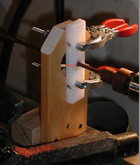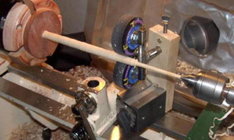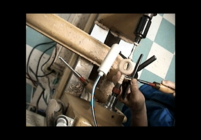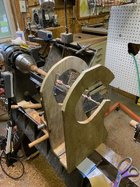Way back in time I built a couple lathe like machines to turn long slender parts, pool cue shafts to be exact. They would have done canes very well. Strictly speaking by the AAW definition they were not woodturning machines. They could go from a square hard maple blank to tapered round ready for sanding in one pass. As you would expect the blanks had to very select straight grained. These were for two piece cues, the butt end being larger diameter were not difficult to turn.
At the time as I recall my customer had paid thousands of dollars to a professional cue maker to see and learn about his "secret" cue turning machine. He came to me with only a verbal description of the design. Basically it was based on a table saw with a lathe like setup holding the blank over the table saw blade. The lathe assembly slowly rotated the blank over the table saw blade doing the cutting as the assembly traversed the length of the cue shaft. The travel was down the length of the shaft like ripping a board. A template was used to create the shaft taper with the lathe pivoting on the template. No steady rests were needed.
Adjusted for inflation the machines would be in the $15K to $20K range today. This was secret stuff back in the day. Now anyone can get ideas by Googling on variations of "table saw lathes". Nowadays some of the better machines are computerized with blank rotation, feed speed and taper all programmable.
The whole situation of this project was different than my usual customer. He came to me with a roll of hundred dollar bills proceeding to peel the hundreds off his roll telling me to stop him when there was enough money for a good start on the project. He moved away from the Seattle area years ago. When I search for him I see his cue sticks are collectable in the high dollar range so apparently he's been quite successful.







